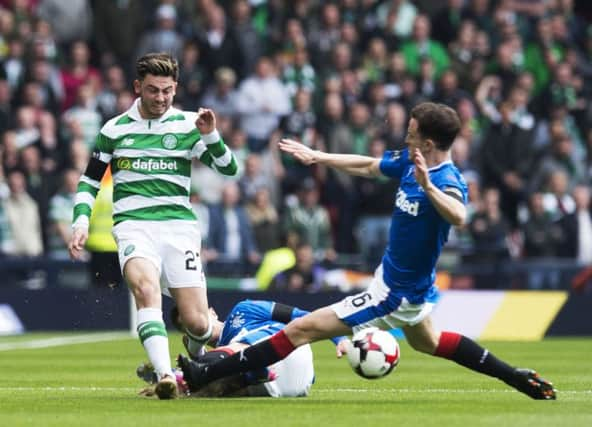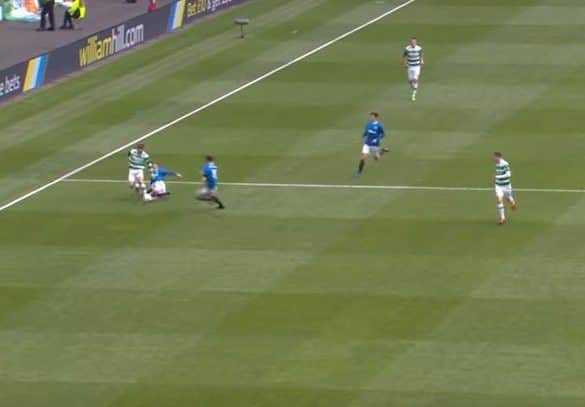Why Rangers' Andy Halliday should have been sent off against Celtic
This article contains affiliate links. We may earn a small commission on items purchased through this article, but that does not affect our editorial judgement.


It is undoubtedly a red card. It’s incredibly late. You can see from Image One (below) that Halliday has only just begun his tackling motion when Roberts gets to the ball first. His right leg is still planted on the ground as he draws back his left to make the challenge.
Advertisement
Hide AdAdvertisement
Hide AdIt’s different from most clear-cut red card in a few aspects: he doesn’t leave the ground with both feet, he leads with only one leg, his studs weren’t showing, and he comes in at a more favourable angle. Regardless the last one, head-on challenges tend to look worse. Had he came in from such an angle, the referee would have been more inclined to produce a red card.


All of this may have worked in Halliday’s favour, though it shouldn’t have. For a tackle to be a red card, the player committing must use “excessive force” while “endangering the safety of an opponent” is also taken into consideration. How anyone could look at this tackle and not think it falls into both of those categories is beyond us.
Halliday absolutely flies into the challenge. He could barely have gone in any harder. Even if he did have a good chance of playing the ball, which he didn’t, it still would have been worthy of a red. There’s no doubt Roberts’ safety is endangered by the action. The Celtic man actually does well to anticipate. He begins to jump out of the way before Halliday crashes into his left leg, which is already off the ground. Had it been planted this could have been a very nasty tackle indeed.
So why doesn’t referee Willie Collum produce a red card? The reasons are similar to a tackle we covered last season when Hearts went to Celtic Park. Scott Brown lunged in two-footed on Hearts striker Juanma within the first 10 minutes and didn’t even receive a booking for the challenge, which angered the visitors as they had their own man sent off later in the game. Halliday’s was worse, but the factors which contributed to the referee making the wrong decision are roughly the same.
First of all, it’s very early in the game. As much as we like to state otherwise, referees don’t want to be the centre of attention. Or, at least, they shouldn’t want to. They’re there to make sure the game is played in the right spirit, but, if possible, they shouldn’t play a part in deciding the outcome. For this reason you’ll rarely see a red card within the first 10-15 minutes of a match. Rightly or wrongly, a referee will be far more lenient than he would be in the last 10-15 minutes.


Furthermore, he’s still getting warmed up himself. It’s not just players who need a little time to get into the flow of the game. A referee also has to be given a little time to judge the spirit of the contest, if there’s any ill-feeling between the players, if there’s a chance things could boil over etc.
This is a little different than the Brown example, because in that match the crowd was pretty quiet at the time. In a Celtic-Rangers game a referee will know that tensions are always running high. Then again, because it is a derby, watched by thousands around the world, he’s likely to be more reticent to produce a red in the opening three minutes.
Secondly, there’s no reaction from the Celtic players or even Roberts himself. Compare this to Brown’s red card against Ross County last week. Just about every member of their squad reacted angrily to the challenge and confronted Brown. There was very little of that from the Celtic players.
Advertisement
Hide AdAdvertisement
Hide AdWe should commend them for this attitude. You don’t want to see players surrounding an opponent or the official. However, it doesn’t change the fact that referees are human and will be influenced by how those around them perceive the same incident. If he’s debating with himself whether it’s a red or not, and no-one else around him is reacting in the manner he would expect from a red card-worthy challenge, then that will impact his decision.
Some have wondered whether Collum forfeited his ability to send off Halliday by playing advantage. While it’s true that referees shouldn’t play advantage if they’re going to send a player off, unless it’s a clear goalscoring opportunity, it doesn’t mean they can’t go back and produce a red card.
Rangers were fortunate again later in the match to keep all 11 men on the field when Myles Beerman committed a pair of fouls on Roberts. The first challenge could easily be considered a red, as we’ve seen them given, but a yellow card was sufficient punishment for such a typically high-intensity contest. However, moments later the same player was deemed to have tripped Roberts as he darted into the Rangers penalty area. It wasn’t a “reckless” tackle, but it was undeniably stopping a “promising attack” and should have resulted in a second yellow.
As for the penalty, there’s no doubt Leigh Griffiths got to the ball before James Tavernier. The Rangers right-back says Griffiths told him it wasn’t a penalty, but it’s likely the Celtic striker was just humouring him.
• Craig Anderson is a former fully qualified referee. He is also the man behind SPL Stats on Twitter.
SEE ALSO